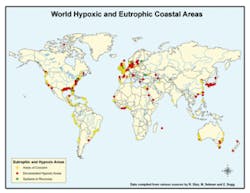Coastal Chokehold
By Paul Mackie
Coastal populations are losing their livelihoods to polluted waters, according to a recent World Resources Institute report.
Coastal communities worldwide are witnessing their livelihoods choked by agricultural and industrial pollution, according to findings released in April by the World Resources Institute (WRI).
“A significant portion of the world’s population – nearly half of which lives within 40 miles of a coast – is vulnerable to harmfully over-enriched ecosystems,” said Mindy Selman, senior associate at WRI and lead author of WRI’s findings. Excessive nitrogen and phosphorus has emerged as one of the leading causes of degraded water quality. WRI identified 415 over-enriched – or “eutrophic” – coastal areas throughout the world. Of these, 169 are depleted of oxygen, creating “dead zones” that are unable to support marine life. Another 233 of the systems identified are experiencing one or more symptoms of eutrophication, including toxic algal blooms, loss of biodiversity, and die-off of coral reefs. Only 13 of the coastal areas identified exhibit signs of recovery.
Some of the coastal areas studied include the Chesapeake Bay, Baltic Sea, Gulf of Mexico, and Tampa Bay. Seventy-eight percent of the assessed continental U.S. coastal area and 65% of Europe’s Atlantic coast are eutrophic.
“There is a dramatic growth in areas receiving nitrogen and phosphorus created by agriculture, sewage, industry, and fossil fuel combustion,” said Robert Diaz, a co-author of the findings and professor of marine science at Virginia’s College of William and Mary.
Over the past 50 years, human activities have caused a doubling of nitrogen pollution and a tripling of phosphorus pollution in coastal areas. By comparison, human activities have increased atmospheric concentrations of carbon dioxide - the gas primarily responsible for global warming – by 32% since the beginning of the Industrial Age.
The most severe form of oxygen depletion in coastal areas has escalated dramatically over the past 50 years, increasing from about 10 documented cases in 1960 to 44 in 1995 to at least 169 today.
The sources of pollution vary by region. In the USA and Europe, agricultural sources such as animal manure and commercial fertilizers are typically the main causes of eutrophication. Sewage and industrial discharges, which usually receive some treatment, are a secondary source. Elsewhere in the world, however, wastewater from sewage and industry is often untreated and a primary contributor to eutrophication. Only 35% of wastewater in Asia is treated, 14% in Latin America and the Caribbean, and less than 1% in Africa.
The full findings appear in “Eutrophication and Hypoxia in Coastal Areas: A Global Assessment of the State of Knowledge,” which can be found along with related maps at the institute’s website.
“The number of degraded coastal areas around the world is sure to be a much greater problem than even our study of 415 areas suggests,” Selman said. “Many countries will need to take initial steps in monitoring their water and eventually reducing pollution through smart policies.” WWi
Author’s Note:
Paul Mackie is media relations director at the World Resources Institute, in Washington, DC, an environmental think tank that goes beyond research to create practical ways to protect the earth and improve people’s lives. Contact: 202-729-7600 or www.wri.org


